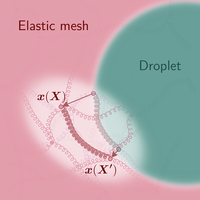Abstract
Recent experiments demonstrated the emergence of regular mesoscopic patterns when liquid droplets form in an elastic gel after cooling. These patterns appeared via a continuous transition and were smaller in stiffer systems. We capture these observations with a phenomenological equilibrium model describing the density field of the elastic component to account for phase separation. We show that local elasticity theories are insufficient, even if they allow large shear deformations. Instead, we can account for key observations using a nonlocal elasticity theory to capture the gel’s structure. Analytical approximations unveil that the pattern period is determined by the geometric mean between the elastocapillary length and a nonlocality scale. Our theory highlights the importance of nonlocal elasticity in soft matter systems, reveals the mechanism of this mesoscopic pattern, and will improve the engineering of such systems.
- Received 1 August 2023
- Revised 16 December 2023
- Accepted 5 March 2024
DOI:https://doi.org/10.1103/PhysRevX.14.021009
Published by the American Physical Society under the terms of the Creative Commons Attribution 4.0 International license. Further distribution of this work must maintain attribution to the author(s) and the published article’s title, journal citation, and DOI. Open access publication funded by the Max Planck Society.
Published by the American Physical Society
Physics Subject Headings (PhySH)
Popular Summary
Phase separation is fundamental for forming patterns in many systems, including synthetic materials and living cells. These patterns are affected by the elastic properties of such systems, which oppose deformations induced by phase separation. Indeed, recent experiments in synthetic systems demonstrated that a regular pattern forms when a sufficiently stiff gel is cooled. These patterns appear continuously, reversibly, and independently of the cooling rate, suggesting they are equilibrium states originating from a trade-off between phase separation and elasticity. Yet, standard descriptions of such systems fail to explain the patterns. We propose a new phenomenological theory, which successfully predicts the formation of regular equilibrium patterns like those in experiments.
Our theory is based on nonlocal elasticity, which accounts for spatially correlated structures of the gel. We show that a combination of the gel’s elasticity and a nonlocality scale control the length scale of the emergent equilibrium pattern. We also hypothesize that the spatial heterogeneity of the gel’s network gives rise to the nonlocality scale. Our work highlights the importance of considering nonlocal elasticity for understanding phenomena occurring on length scales comparable to the correlation length of the material’s structure.
The insights from this work could advance the control of engineered patterns in soft-matter systems and improve our understanding of biological cells.



